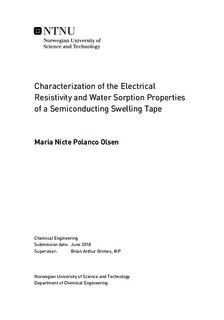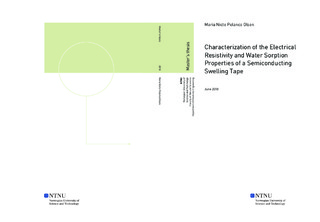| dc.description.abstract | In presence of moisture and localized field enhancements water trees might develop within the polymeric insulation of HV subsea power cables. Water trees tend to grow unnoticeable and deteriorate the insulation properties with time. The humidity within the insulation can efficiently be reduced through the application of semiconducting swelling tapes. Semi conducting swelling tapes provide a unique combination of electrical conductivity and a large water retention capacity. This is attributed to the presence of conductive carbon black (CB) and superabsorbent polymer (SAP) particles, respectively.
To understand the mass transport properties of water vapor within a swelling tape, transport coefficients were determined. The sorption of water vapor revealed concentration dependent transport coefficients and a general increase in diffusion and solubility with increasing water activity. This was attributed to the hygroscopic and polyelectrolyte properties of the SAP components and resulted in an increase in diffusivity by a factor of 100, when increasing the relative humidity (RH) from 7 to 65 %. At higher water activity, it was assumed that the formation of immobile water clusters reduced the diffusion of water vapor. Several sorption modes were suggested for the sorption behaviour of the tape between 10 to 80 % RH.
The introduction of conductivity within the tape reduces potential differences throughout several cable layers and subsequent field enhancements. However, conductivity and water sorption properties of the semi-conductive swelling tape can be altered by mechanical compressions, exerted by surrounding cable components. The electrical resistivity of a humid swelling tape under load was therefore determined. Due to the anisotropy of the tape, electrical resistivity measurements were performed across (radial direction) and along with (axial direction) the tape. The radial and axial directions of the tape were dominated by the presence of SAPs and CBs, respectively. A significant reduction in radial resistivity of the tape was observed when increasing the humidity from 40 % to 60 % RH. The resistivity decreased by a factor of 100. No significant effect of compression was observed, but the tape showed a decreasing trend in resistivity with increasing compression. At 60 % RH radial resistivity approached axial resistivity, and the influence of SAPs is reduced. The axial resistivity was around 18 Ωcm. The axial resistivity of the tape was less affected by humidity and compression than the radial resistivity.
Ageing reveal deterioration of swelling height, but had no influence on tape resistivity. | |

